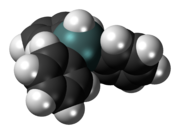Triphenyltin hydride is the organotin compound with the formula (C6H5)3SnH. It is a white distillable oil that is soluble in organic solvents. It is often used as a source of "H·" to generate radicals or cleave carbon-oxygen bonds.

| |

| |
| Names | |
|---|---|
| IUPAC name
Triphenylstannane
| |
| Identifiers | |
3D model (JSmol)
|
|
| 3544353 | |
| ChEBI | |
| ChemSpider | |
| ECHA InfoCard | 100.011.789 |
| EC Number |
|
| 6741 | |
PubChem CID
|
|
| RTECS number |
|
| UNII | |
CompTox Dashboard (EPA)
|
|
| |
| |
| Properties | |
| C18H16Sn | |
| Molar mass | 351.036 g·mol−1 |
| Appearance | colorless |
| Density | 1.374 g/cm3 |
| Melting point | 28 °C (82 °F; 301 K) |
| Boiling point | 156 °C (313 °F; 429 K) (0.15 mm Hg) |
| insoluble | |
| Solubility in benzene, THF | soluble |
| Hazards | |
| Occupational safety and health (OHS/OSH): | |
Main hazards
|
toxic |
| GHS labelling: | |
 
| |
| Danger | |
| H301, H311, H331, H410 | |
| Flash point | >230 °F |
| Related compounds | |
Related compounds
|
SnCl4, (C6H5)3SnCl, (C6H5)3SnOH |
Except where otherwise noted, data are given for materials in their standard state (at 25 °C [77 °F], 100 kPa).
| |
Preparation and reactions
editPh3SnH, as it is more commonly abbreviated, is prepared by treatment of triphenyltin chloride with lithium aluminium hydride.[1] Although Ph3SnH is treated as a source of "H·", in fact it does not release free hydrogen atoms, which are extremely reactive species. Instead, Ph3SnH transfers H to substrates usually via a radical chain mechanism. This reactivity exploits the relatively good stability of "Ph3Sn·"[1]
References
edit- ^ a b Clive, D. L. J. "Triphenylstannane" in Encyclopedia of Reagents for Organic Synthesis (Ed: L. Paquette) 2004, J. Wiley & Sons, New York. doi:10.1002/047084289X.rt390